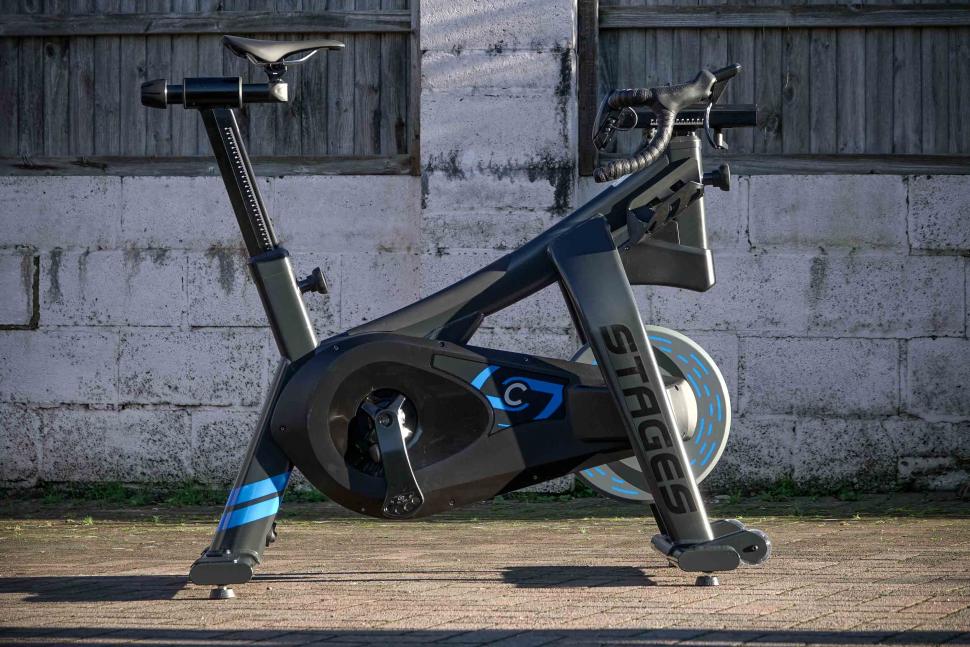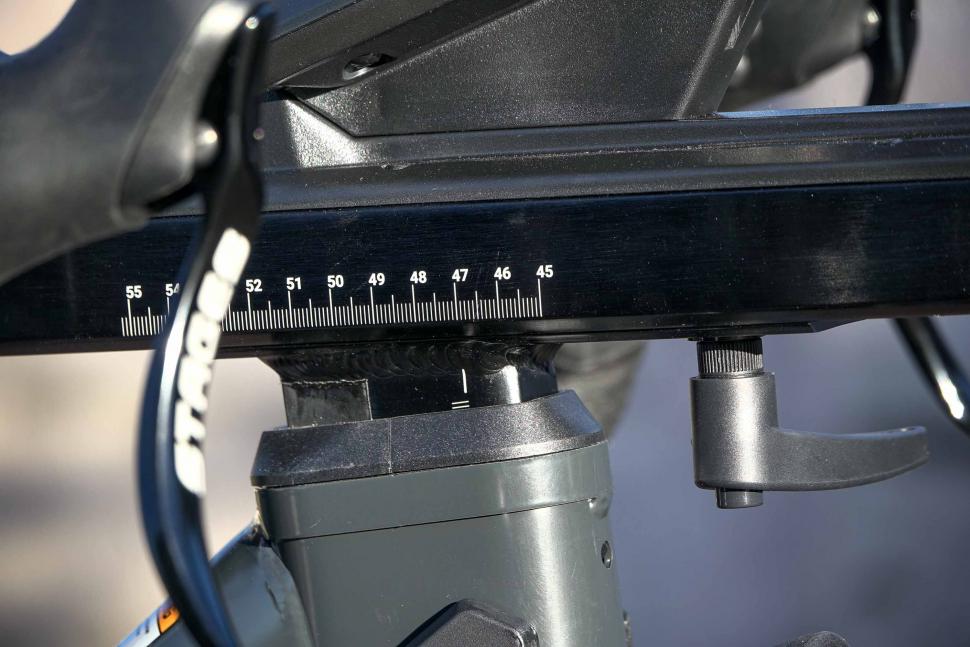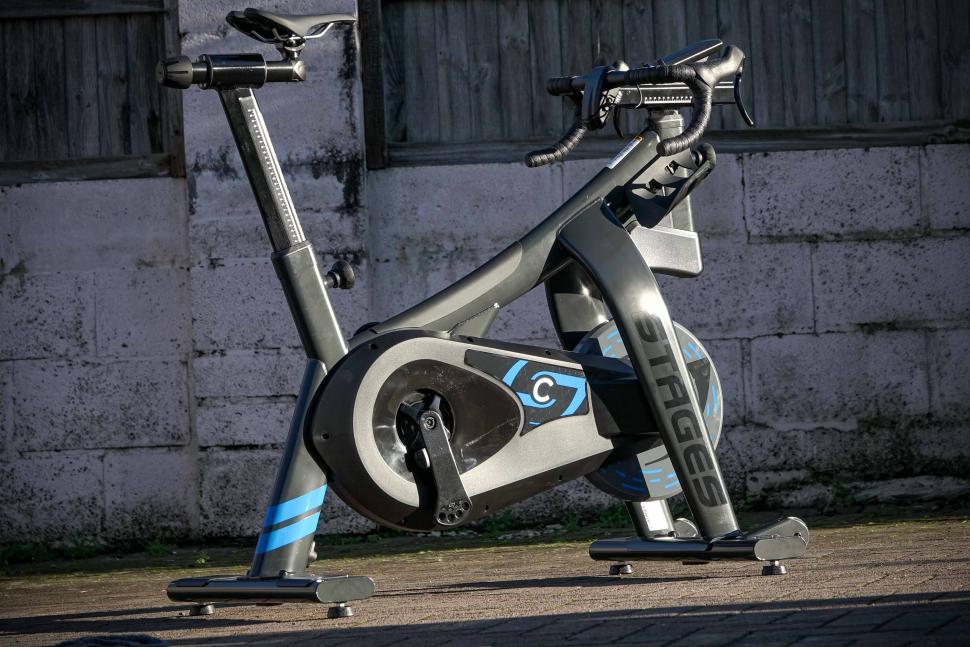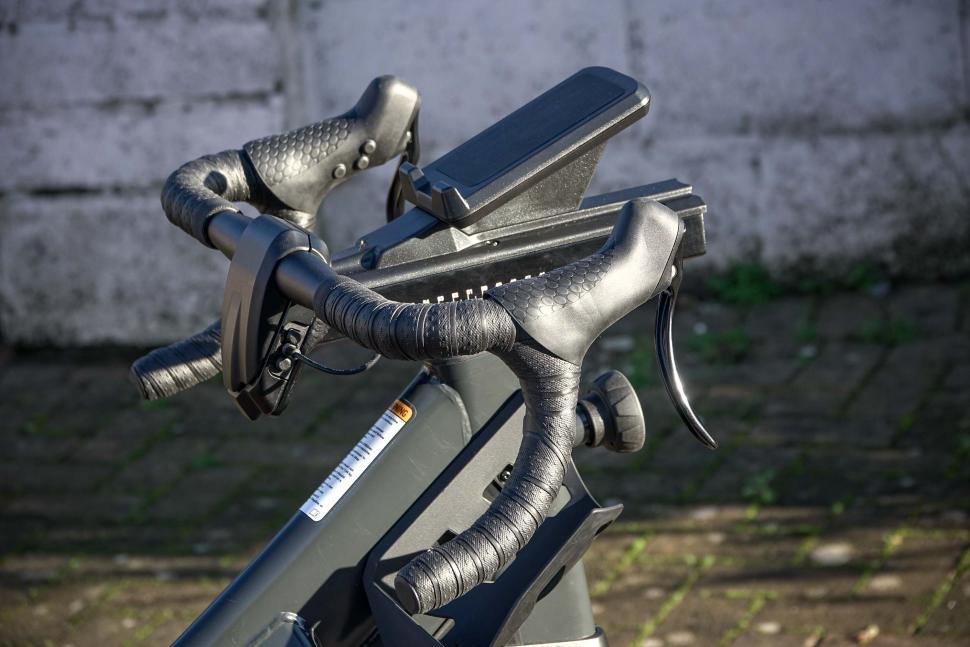- News
- Reviews
- Bikes
- Accessories
- Accessories - misc
- Computer mounts
- Bags
- Bar ends
- Bike bags & cases
- Bottle cages
- Bottles
- Cameras
- Car racks
- Child seats
- Computers
- Glasses
- GPS units
- Helmets
- Lights - front
- Lights - rear
- Lights - sets
- Locks
- Mirrors
- Mudguards
- Racks
- Pumps & CO2 inflators
- Puncture kits
- Reflectives
- Smart watches
- Stands and racks
- Trailers
- Clothing
- Components
- Bar tape & grips
- Bottom brackets
- Brake & gear cables
- Brake & STI levers
- Brake pads & spares
- Brakes
- Cassettes & freewheels
- Chains
- Chainsets & chainrings
- Derailleurs - front
- Derailleurs - rear
- Forks
- Gear levers & shifters
- Groupsets
- Handlebars & extensions
- Headsets
- Hubs
- Inner tubes
- Pedals
- Quick releases & skewers
- Saddles
- Seatposts
- Stems
- Wheels
- Tyres
- Health, fitness and nutrition
- Tools and workshop
- Miscellaneous
- Buyers Guides
- Features
- Forum
- Recommends
- Podcast
review
 Stages SB20 Smart Bike Indoor Trainer
Stages SB20 Smart Bike Indoor Trainer£1,699.00
VERDICT:
Solid, quiet and accurate indoor trainer for high-volume riders
Reassuringly solid
Quiet
Easy to adjust
Reliable and accurate power
Configurable gears
Good ride feel
No gear display
Power meters have separate batteries
ERG mode needs work
Shift buttons are a bit fiddly
Too expensive at rrp
Weight:
75,000g
Contact:
At road.cc every product is thoroughly tested for as long as it takes to get a proper insight into how well it works. Our reviewers are experienced cyclists that we trust to be objective. While we strive to ensure that opinions expressed are backed up by facts, reviews are by their nature an informed opinion, not a definitive verdict. We don't intentionally try to break anything (except locks) but we do try to look for weak points in any design. The overall score is not just an average of the other scores: it reflects both a product's function and value – with value determined by how a product compares with items of similar spec, quality, and price.
What the road.cc scores meanGood scores are more common than bad, because fortunately good products are more common than bad.
- Exceptional
- Excellent
- Very Good
- Good
- Quite good
- Average
- Not so good
- Poor
- Bad
- Appalling
The Stages SB20 is a solidly built, good quality smart bike with lots going for it. Overall it outperforms the Wattbike Atom, which is the bike it's most directly competing with. It's at the expensive end of the market for true smart bikes, and it's not quite as accomplished as some of the others out there, but overall it's a very good option for heavy use indoors.
If you're a cyclist, you'll probably know Stages because it makes crank-based power meters. But for most of the rest of the world, Stages is a company that makes spin bikes for gym bunnies.
The SB20 is basically the meeting of those two worlds: it's the Stages crank power tech built into a frame that's based on the company's SC range of gym bikes, with the dumb spin transmission replaced by an electromagnetic resistance unit acting on a huge 23kg flywheel, driven by a quiet and reliable Gates carbon belt.
The SB20 offers up to 2,200W of resistance, which should be plenty unless you regularly win on the track sprint circuit, and gearing is virtual, and configurable to your preference. More on that in a bit.
The SB20 is designed for heavy use indoors with a smart training app, and plenty of thought has gone into making it ideal for that. You can charge your phone or tablet via USB while you're riding, and there's a phone tray and an optional iPad holder supplied. There are two water bottle holders either side of the bike which will accept pretty much any bottle, so you're not limited to bike bidons – you can use your gym bottle if you like. The bike is ANT+ and Bluetooth compatible, so it'll work with anything you're likely to be running a training app on.
It's a reassuringly solid thing, the SB20. Don't, under any circumstances, attempt to move the 70kg box by yourself, unless you want a hernia. Once it's out of the box and assembled, which is surprisingly easy, it's not that difficult to manoeuvre on its two skate wheels, but if you need to lift it into position or up any stairs, make sure you've got a burly friend to hand.
Like all smart bikes, one of the great things about having a static rig like this is the adjustability. You can change everything here: saddle height and offset, stack, reach, crank length... you can even swap out the bars if you like.
This is great news if there's more than one person in your household who wants to use the bike; assuming you can both get on with the same crank length (moving pedals is a faff), the other tweaks can be done in less than a minute, especially if you've made a note of the settings. It might take you a few goes to get it dialled in, but once you do the setup is easily repeatable.
I mentioned before that the SB20 uses Stages' crank-based power technology. It's the Stages Gen 3 dual-sided power meter, which delivers +/- 1.5% accuracy and is relied on by a number of WorldTour pro teams.
This is in one sense good, as it's well proven at WorldTour level and is well-developed and reliable. It's less good in another sense though: the two power meters run on their own 2032 coin cells, like they would on your bike. That means that even though you're plugging the bike into the mains for the electromagnetic resistance, you'll still be faffing about replacing the power meter batteries from time to time. Generally they're good for around 100 hours, which if you're keen is only going to be a few months. It's not a deal breaker, but you just know they're going to go on the blink before (or in the middle of) that important Zwift race you've been working up to.
Workout workings out
Okay, let's have a look at some numbers. Here's a plot of a power benchmarking workout I often do, because it covers a lot of my cycling power range and you can also change a couple of other variables along the way, and see how ERG mode works. I was benchmarking the SB20 against Garmin's Rally 200 double-sided pedals, which I've found to be accurate and reliable over a range of these tests.
Firstly, and most obviously: the SB20 is doing a good job here. For this test the bike is reading slightly under the pedals (212W vs 219W), whereas for other rides that have been at a higher intensity (races, for example) the Stages bike read above the pedals and not below. You can see that it does both here, at different points in the ride, but generally the blue line is slightly under the purple one.
> What is FTP? 7 key facts to learn about functional threshold power, a major training metric
At intensities around 100% FTP, the two power meters agree most closely. The first three intervals after the warm-up are 110-130% of my FTP, and the difference between the two traces is only about 3W here. As you go further up the intensity scale the gap tends to increase: when we get to the two sprints at the end (225% and 250%) the gap between the two is about 10%, whereas in the FTP zone it's more like 1%.
The two power meters respond differently to standing efforts, too. Intervals two and four are standing, and the lines diverge a bit more there, with the discrepancy more like 3%. Because I'm cycling at a lower cadence it may be down to the sampling rate of the different power meters, or more likely they just respond differently to a less even pedal stroke, which is what you get when you stand up.
And which is right? Impossible to say, really. I'd have no issues with either of these power traces independent of the other, and the differences are quite subtle. Neither of them are exactly right, and both of them are close enough. The numbers I was seeing made me competitive with the people I'd be competitive with outdoors, so they're entirely believable.
I ran this test in ERG mode, where the trainer tries to adjust the resistance to output the correct power based on your cadence. I wouldn't say that the SB20 is especially good at this, compared to its direct rivals and other direct drive trainers I've used. Here are some reasons why.
When you're riding at a constant cadence the SB20 doesn't (generally) fall into the trap of increasing the resistance too far, and then dialling it back, which results in a power spike at the front of each interval. That's good, but it goes a bit far the other way. The ramp up is too slow, so when you're doing something like a 10-second sprint effort you generally don't make it up to the target power. The last spike on the graph is a 675W effort on paper, but I didn't even make it to 600W before the interval was over. That was common. Also, it's not like the bike adjusts more slowly to make sure it gets it right, and then sits there: you still get a fair bit of variation in the power.
Ending high-power intervals and moving to low-power recovery is another thing that the SB20 seems to have some issues with. It often takes a while for the resistance to drop, and then when it does it drops too far. This is especially noticeable in the second interval here, when the bike held onto the interval for at least five seconds too long, then dropped the power all the way down to about 50W before ramping it back up again to the recovery level of 145W. The Stages bike consistently had problems with high to low power. Or, rather, it inconsistently had problems with it, which is worse.
Overall, the ERG experience wasn't that great, really. Compare that trace to the same workout performed on a Saris H3, which is about the best ERG trainer at the moment. Zwift gives you a star for every power interval it reckons you hit. The H3 scored 21/21, every time. The SB20 was normally around 15/21.
Moving away from ERG mode, if you're riding around in Zwift/RGT/Rouvy then there are two other ways to affect the resistance. On the one hand, the gradient changes in whatever virtual world you're exploring will be relayed to the bike and the resistance will change accordingly. On the other hand, there are shift buttons on the levers that allow you to change the resistance manually, just like changing gear. There are three buttons on each lever, and when you've got the bike hooked up to the Stages Link app on your phone you can assign different functions to them.
There are a whole bunch of standard setups available through the app, with both single and double chainring transmissions mimicked. You can also choose to use Dream Drive, which gives you a sequential setup with up to 50 gears. I tried out a few and ended up going with Dream Drive with 20 gears, as that gave decent jumps between the gears and was easy to remember: right hand buttons to make it harder, left hand buttons to make it easier. For me the buttons aren't spaced widely enough to be distinct, so having upshift and downshift next to each other on one lever led to a lot of mis-shifting, especially in sprints where grabbing the hood can accidentally press them. They're all just a bit small and close together.
The gear change itself is decent enough; it's not the realistic clunk that you get on the Tacx Neo Bike Smart and it's not quite as good as the Wahoo Kickr Bike either, but it's faster than the Wattbike and pretty easy to get used to. There's no screen to tell you what gear you're in, so if you want that information you'll need to pair with the Stages Link app on your phone, which is fine if you don't also want to use your phone to run Zwift Companion. I ended up running two phones, one for each. You get the same kind of issue with the Wattbike Atom; both the Kickr and the Neo bikes have a gear display, although one (the Kickr's) is bad and the other (the Neo's) is good.
Stages makes big play of the size of the freewheel on the SB20 (22.5kg) and how it gives an 'incredibly realistic feel when climbing, accelerating and coasting'. That's fair: the ride feel of the SB20 is pretty good all round. I found that it was a bit easy to wind up on flat sprints compared to my usual trainer, a Tacx Neo 2, and that made sprinting quite a high cadence effort, but overall I was really happy with the experience of being on board the SB20. It's quiet, and solid, and easy to settle into for longer indoor efforts.
Is it 'the only bike that can deliver the realistic inertia of outdoor riding', like Stages claims? Not really, no. Having ridden all of the main static smart bikes now, I'd put the ride feel of the SB20 more or less on a par with the Wahoo Kickr Bike, and it's better than the Wattbike Atom, but for me the Tacx Neo Bike Smart is still the best in terms of its ride quality. It's still, for me, the one to beat overall, too. It comes with daft weedy fans that are pointless, but nearly everything else is on point: excellent ride feel, solid frame, great adjustability, useful display.
> Buyer’s Guide: 10 of the best home trainers – get fit indoors
At full retail the SB20 is £500 more than the Tacx, and at that price I wouldn't consider it. But realistically you can find both of those bikes and the Wattbike Atom for around the same money, with the more complicated Kickr Bike costing considerably more.
Conclusion
Like any static smart bike, the Stages SB20 makes a lot of sense if you're going to put a lot of miles into your legs indoors, and especially if more than one person wants to ride. The SB20's main plus points are the super-solid build, the quiet running and the accurate power numbers. For me it's not best in class – the ERG performance was a bit disappointing, and there are a few hardware niggles too – but it's still a very good option for high-volume indoor training.
Note: The original value score and conclusions were made based on the rrp at the time, and the Stages SB20 is currently discounted to £1,699.
Verdict
Solid, quiet and accurate indoor trainer for high-volume riders
If you're thinking of buying this product using a cashback deal why not use the road.cc Top Cashback page and get some top cashback while helping to support your favourite independent cycling website
road.cc test report
Make and model: Stages SB20 Smart Bike Indoor Trainer
Size tested: n/a
Tell us what the product is for and who it's aimed at. What do the manufacturers say about it? How does that compare to your own feelings about it?
Stages says: "Real bike feel. Real bike fit. Responsive, wide-range electronic resistance and a 50 lb flywheel for an incredibly realistic feel when climbing, accelerating and coasting. Precision dual-sided power meter. User configurable electronic shifting with sprint buttons. Smooth, silent Gates belt drive. Compatible with your favorite training and simulation apps and built on a decade of commercial studio bike experience by the indoor cycling experts at Stages."
Tell us some more about the technical aspects of the product?
Stages lists:
REAL WORLD GEARING
Shimano or Campagnolo electronic and manual shifting to match your real world cycling. Configured with the Stages Link app.
CUSTOM GEARING
Select from a traditional 53/39t and 11-28t road setup to a 1x12 modern MTB setup, with lots of options in between.
RESISTANCE FEEL
Smooth, silent electronic resistance provides up to 2,200 watts of stunningly realistic road feel.
DREAM DRIVE
Dream Drive provides a sequential virtual drivetrain with up to 50 gears, up to a 55-11t high gear and a 1:2 low gear.
TAKE YOUR INDOOR RIDE TO THE NEXT LEVEL
The smooth, silent and ultra-stiff SB20 Smart Bike outperforms any bike and wheel-off smart trainer combination. Say goodbye to drivetrain wear, noise, and messing with greasy drivetrains.
The SB20 ready to go whenever you are, and can be shared with other riders in your household. Simply put, if you're serious about indoor cycling, you need an SB20.
WORLD CLASS STAGES POWER
7 Grand Tours, 25 World Championships, 50 National Championships from the power meter that changed the cycling industry.
Always train with an accurate and reliable power meter. A Stages Gen 3 dual-sided power meter delivers +/- 1.5% precision power measurement. Train at home with the same meter the pros swear by. Multiple Tour de France victories can't be wrong.
CONNECT TO YOUR FAVORITE APPS
The ANT+ and Bluetooth connected SB20 is optimized for the most popular indoor cycling platforms.
Over 10 years of delivering cycling data to the world's top teams gives us an edge to deliver the most robust connection to maximize your uninterrupted training enjoyment. Select your desired platform and the Stages Link app allows you to select the optimal gearing and controls to get the best out of your experience on the fly.
REAL BIKE FEEL
The SB20 has the most realistic feeling of riding an outdoor bike indoors.
Customize and tune your exact virtual setup. The 50lb flywheel is what really makes the SB20 stand out. It is the only bike that can deliver the realistic inertia of outdoor riding making climbing, acceleration and coasting feel spot on.
BEST IN CLASS CONTROL MODES
SIM, Workout, ERG and Manual modes enhance every ride experience.
The SB20 is packed with the most important control modes to offer a variety of riding experiences when using 3rd party apps or with the Stages Link app.
Rate the product for quality of construction:
9/10
Very solid and well built.
Rate the product for performance:
7/10
Good overall, some niggles with ERG and some hardware choices.
Rate the product for durability:
9/10
Definitely built for the long haul.
Rate the product for weight (if applicable)
10/10
Exceptional in its heaviness.
Rate the product for comfort (if applicable)
8/10
Easy to get the fit dialled in.
Rate the product for value:
4/10
It's a bit expensive at rrp, though the prices you'll find it for sale are on a par with others.
Tell us how the product performed overall when used for its designed purpose
Very well.
Tell us what you particularly liked about the product
Reassuringly solid, quiet, easy to adjust, reliable and accurate power, configurable gears, good ride feel.
Tell us what you particularly disliked about the product
No gear display, power meters have separate batteries, ERG mode needs work, shift buttons are a bit fiddly.
How does the price compare to that of similar products in the market, including ones recently tested on road.cc?
At rrp it's more expensive than rivals from Tacx and Wattbike, with the Wahoo considerably more.
Did you enjoy using the product? Yes in the main.
Would you consider buying the product? I'd probably opt for the Tacx bike.
Would you recommend the product to a friend? Maybe
Use this box to explain your overall score
Just nudging into an 8 here: performance overall wasn't maybe as good as I'd hoped, especially in ERG mode, but it's easy to live with, solid, accurate and quiet.
About the tester
Age: 49
I usually ride: whatever I'm testing... My best bike is: Kinesis Tripster ATR, Merida Scultura, Dward Design fixed
I've been riding for: Over 20 years I ride: Every day I would class myself as: Expert
I regularly do the following types of riding: road racing, time trialling, cyclo cross, commuting, touring, club rides, sportives, general fitness riding, fixed/singlespeed, mtb, Mountain Bike Bog Snorkelling, track
Dave is a founding father of road.cc, having previously worked on Cycling Plus and What Mountain Bike magazines back in the day. He also writes about e-bikes for our sister publication ebiketips. He's won three mountain bike bog snorkelling World Championships, and races at the back of the third cats.
Latest Comments
- Bungle_52 3 min 27 sec ago
I have some sympathy. You have to pay out for excise duty and MOT irrespective of how often you use a vehicle so it probably makes economic sense...
- OldRidgeback 26 min 48 sec ago
Interesting, tho they only take narrow 20" slick tyres. I'd want to be able to use 1.75 Maxxis DTHs.
- don simon fbpe 54 min 48 sec ago
Who'd've thought that a certain whinging section (right whingers get uppity for calling them what they are) of society would resort to division,...
- Exup 2 hours 27 min ago
At least some justice is being done........
- BIRMINGHAMisaDUMP 2 hours 37 min ago
I imagine the Police treat bike theft as an insurance issue rather than a criminal issue. Can't blame them to be honest. The best thing is to use...
- David9694 3 hours 3 min ago
Police launch investigation into destruction of barber shop in Hythe High Street...
- ktache 11 hours 33 min ago
I'd love for them to put a number on that "inappropriate speed"
- Nick T 12 hours 26 min ago
They need to use some harder material for the cleat retention clip really, that's worn out long before any bearing has had a chance to fail on...
- yiipeeia 15 hours 16 min ago
I am 67 and I cycle with two groups during the year The Haddenham Easyriders International who ride during the summer on Thursday evenings, and The...
































Add new comment
2 comments
So £2.5k for iffy ERG? Not one to choose if a Zwifter then.
If I recall correctly one of the Stage's USP's when I looked its that its min rider height was considerably less than the others - which means more usable by small Misssuses and kids.
Personally I dont find the Tacx Fan's weedy. Fine for Winter usage when 2 degree outside air is coming in the room. No good for Summer when there's not that temp gradient between inside and out. (YMMV)
This is exactly what motivated "our household" to get one - my better half is ~4'10" and I'm 5'11". It was the only one that I could confidently buy knowing that she would fit on it without trying it in person.
Can confirm that the ERG is a bit dopey, especially when jumping a long way i.e. on intervals, but the thing is built like an absolute tank.